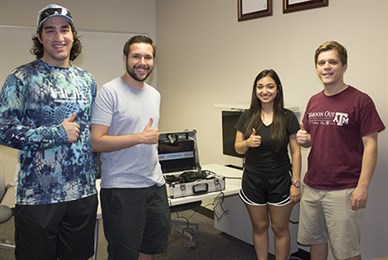Two student groups in the Department of Computer Science and Engineering at Texas A&M University proposed two very different, but equally inventive, projects for their microcomputer systems course this spring.
The first group, comprised of computer engineering seniors Sebastian Escalante, Miguel Nava, Austin Nelson and Samantha Ray, created an LED display board with the capability to translate what an Amazon Echo Dot hears into Morse code.
The idea behind the project was to create a system that listens to the ambient sound in the room and subsequently filters and identifies what the Dot heard. This was done by using sound filtering to isolate the significant sounds from miscellaneous noise.
The device has two major modes for sound identification. The first mode focuses on identifying tones in music and the second focuses on identifying the source of sounds. The software will be able to identify common household sounds, such as the slamming of a door, knocking, footsteps or a dog barking, and display the name of the source on the LED light board.
Additionally, the device will be able to distinguish between the voices of different individuals and remember their names.
This sound analysis system has the potential to be used for household security and assisting hard-of-hearing individuals.
 Another student group, comprised of computer engineering juniors Briana Martinez, Clayton Joseck, Jordan James and Joshua Duncan, created a system that allows users to play old video games, such as Super Mario Bros., using an Xbox Kinect. It is a self-contained system with a monitor, so players are able to simply just plug it in and play.
Another student group, comprised of computer engineering juniors Briana Martinez, Clayton Joseck, Jordan James and Joshua Duncan, created a system that allows users to play old video games, such as Super Mario Bros., using an Xbox Kinect. It is a self-contained system with a monitor, so players are able to simply just plug it in and play.
“The Kinect takes in the raw input from the user using the Windows Software Development Kit (SDK) to track both elbows and wrists and their position relative to your head and waist,” Duncan said. “This helps control left and right and up and down controls.”
Martinez said that one of the biggest challenges they faced while creating this system was that most open-sourced software does not have the skeleton tracking capability that’s needed for a movement tracking application, such as a Kinect.
Being able to overcome this, their system allows the user to relive their favorite childhood games with the ease and excitement found in current technology.
While each project presented unique challenges, both teams finished the semester strong and learned a lot throughout the process. Dr. Jyh-Charn (Steve) Liu, professor, was the instructor for the course.